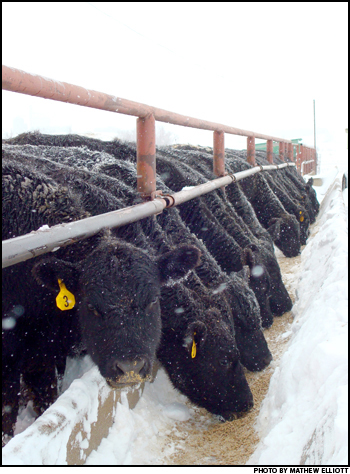 Winter Woes
Winter Woes
Snowstorms, high winds and low temperatures can cause cattle production loss.
Cattle typically can withstand a single snowstorm. However, this winter's back-to-back snowstorms combined with high winds and low temperatures mean cattle may not make it to market as fast, a University of Nebraska-Lincoln (UNL) beef cattle specialist says.
Keeping cattle fed, dry and comfortable is critical for accomplishing production goals, said Terry Mader, UNL beef cattle specialist.
"These wintry conditions mean producers must put forth greater efforts to ensure cattle have adequate access to feed and water, and producers also must provide greater quantities of feed to offset the extra energy they need to maintain desired levels of production," Mader said. "Under cold and windy conditions, which we are experiencing this winter, cattle energy requirements just for maintenance increase by at least 50%."
If cattle's hair coat is muddy or wet, maintenance requirements may be twice normal levels needed for maintenance, which for feedlot cattle may result in 10 to 20 more days on feed before cattle can go to market.
"Winter arriving early often ends up as a long winter," Mader said. "Hopefully, that will not be the case this year, but the recent extensive and abundant snowfalls have left many open cattle operations covered with snow with limited access to dry areas for feeding and caring for the cattle."
For cow-calf operations, it is important that cattle get extra feed during bad weather, especially if cornstalks or other feed supplies are frozen, covered or hard to access.
"It also is imperative that average body condition be maintained in cows if we expect to have healthy calves and normal conception rates," Mader said. "Dry calving areas are essential with wind protection provided where possible."
For feedlot cattle operations, keeping the cattle and pens dry by providing extra space or bedding will aid in maintaining performance and keep cattle healthier.
"Interestingly, heavier cattle, within 30 days of being finished, seem to be affected more by these conditions than lighter-weight cattle," Mader said. In many cases, heavy cattle exposed to environmental stress fail to resume normal feeding activity, which results in limited gain and extremely poor feed efficiencies.
"In this case, it might be better to ship these cattle early rather than try to obtain additional weight gain requiring extra feed and days on feed," Mader said. On average, cattle fed in the winter with wind protection have only slightly better performance than cattle fed without wind protection.
"However, under conditions experienced this winter, windbreaks have been found to be very useful for all cattle groups, especially for heavyweight cattle," Mader said. New cattle coming into the feedlot also are more susceptible to cold stress. They may need shelter and/or bedding to maintain health and stay on feed.
"It is OK to change to a higher roughage diet when a snowstorm hits, to minimize overeating or acidosis, but don't be too aggressive in making ration changes," he said. "Even though there is more heat in roughage per unit of digestible energy, there is more heat in grain per unit of weight. Also, the more stable we can maintain the rumen environment, the better off the animal is."
Comment on this article.
[Click here to go to the top of the page.]





